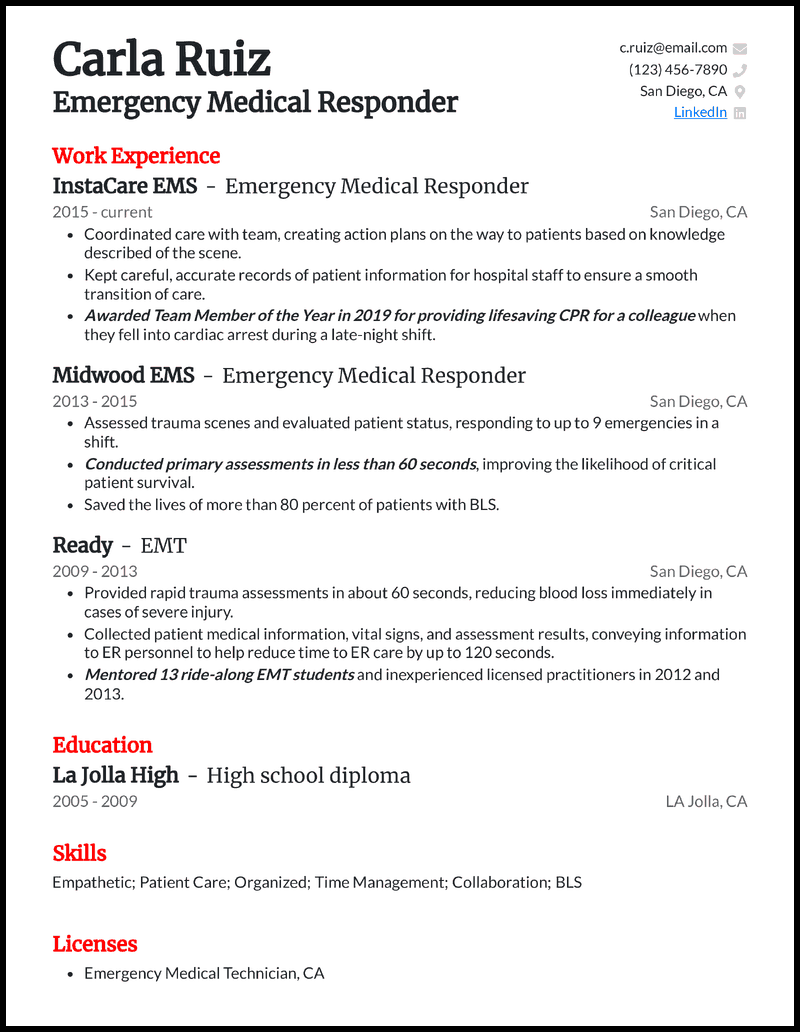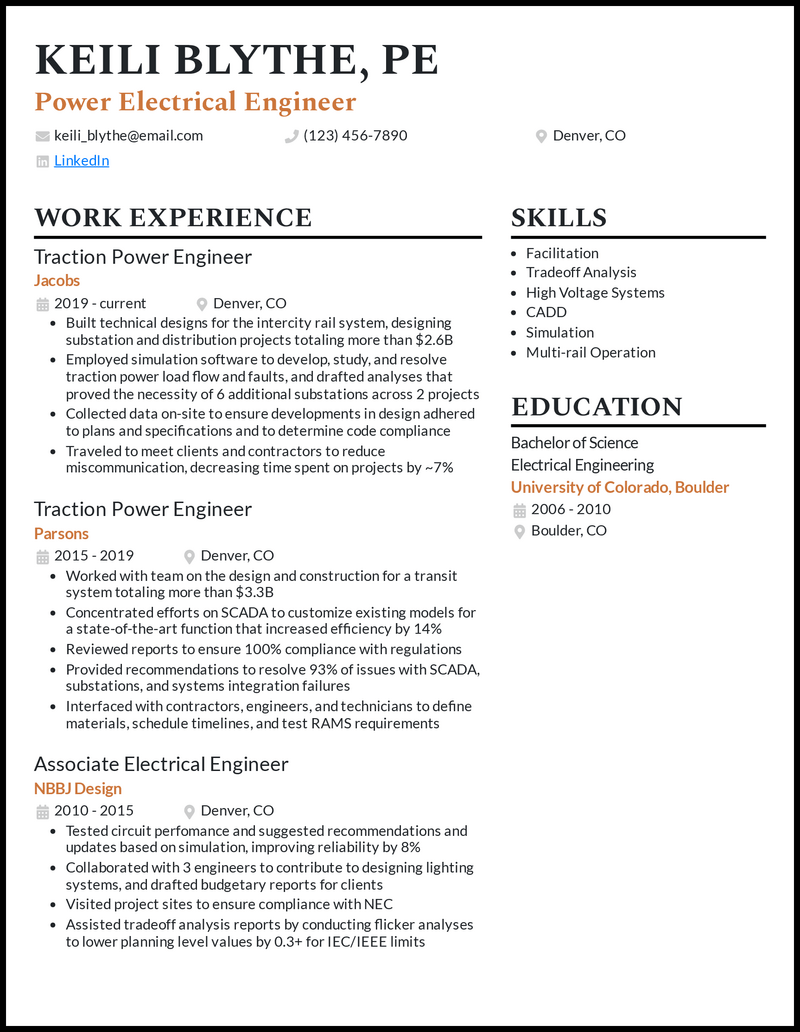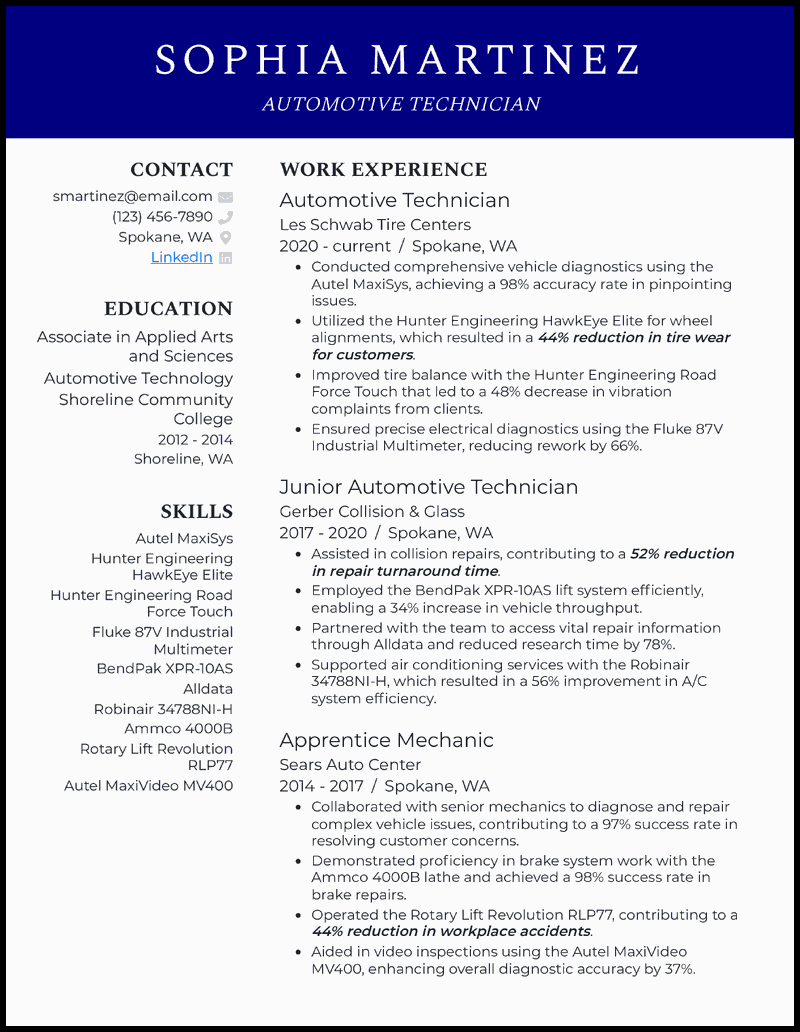When you’re in the job market, your resume is one of the first things hiring managers review to learn about you. So, you want to optimize yours to ensure it’s as successful as possible. However, a common question is, how long should your resume be?
If you’ve reviewed resume templates from different sources, you may have realized there’s some debate on this topic. On one end, you have hiring experts recommending multi-page resumes to ensure you include enough relevant skills and experiences. Then, others favor a concise one-page resume to focus on your most essential abilities for fast-paced review processes.
What’s the ideal option? We’ll break down how to select the best resume length in this article.
Determining the Ideal Resume Length

The ideal length for your resume can vary depending on your field and level of experience. In this section, we’ll recommend the best resume length for most people, best practices to ensure yours is impactful, and instances where you might need a longer resume.

Should your resume be one page?
A one-page resume is usually recommended for most people. In the current job market, many job openings receive hundreds of applicants. That’s especially true with remote jobs becoming more common. Employers will have more job seekers reaching out when they’re open to hiring those located across the country or worldwide.
To give yourself the best chance of success in fast-paced hiring processes where you’re going up against hundreds of others vying for the same position, keeping your resume brief while highlighting the most relevant abilities in your resume skills and experiences sections will help you rise to the top.
In addition, when hiring managers review resumes consistently, they get quick at identifying qualified applicants. It’s estimated that hiring managers make a first impression on resumes within six to eight seconds. That’s why using a resume outline that provides a professional structure and optimizes readability is essential to making it through those fast initial reviews.
For example, consider someone who’s applying to a customer service role at a company that emphasizes skills in Zendesk, Microsoft Office, and multi-line phone systems.
The applicant with everything neatly tied together on one page will likely have a better chance of getting the hiring manager’s attention immediately since they’ll clearly see examples like how you used Microsoft Excel for 56% more accurate customer data management.
Compare that to the applicant who has similar relevant experience buried on a second page, which will probably get missed since the hiring manager doesn’t have enough time to review it all.
One-page resumes are also great for entry-level applicants to concisely portray their most relevant education and abilities.
Even if you don’t have much experience, fill out a full page so your resume looks complete. You can add more details about education, projects, hobbies & interests, or non-traditional work like volunteering to provide a well-rounded overview of what you bring to the table.

When to extend beyond one page
While keeping it to one page will create a good standard resume for most people, there are some cases where extending it beyond a single page would be a good idea. The two most likely scenarios would be if you have extensive experience that’s all relevant in the hiring process or when you’re applying to a highly technical position.
Extending your resume beyond one page is best for job seekers with ten or more years of experience in their field. Plus, certain types of high-level jobs may require you to show an extensive amount of experience. That can include:
- Executive roles like CEOs or CFOs often require a long tenure of effectively managing corporate finances or operational procedures.
- Senior finance roles, like senior accountants, where you must showcase long-standing compliance and accuracy.
- Lead scientific roles, like a head medical researcher, that require an accurate and effective history in the lab.
- Senior criminal defense roles, such as senior attorneys, where you may want to display lots of successful litigation and cases managed.
- High-level law enforcement, such as police captains, would want to show a long tenure of safety and accuracy in the field and managing teams.
Highly technical positions like software architects, engineers, or electricians, where you may need tons of skills to be successful on the job, could also benefit from longer resumes. For example, a software engineer may need to know several coding languages, design and data management software, and be able to follow strict industry regulations.

Balancing detail with brevity
While some instances require extending your resume beyond one page, you still want to ensure it’s as concise as possible and includes only the most essential details for fast-paced hiring processes. Some tips to help you achieve the ideal balance are:
- Only include your most relevant experiences: Even if you have ten or more years in your field, consider if all your work history is still relevant. For instance, if you’re applying to a management role, you can probably remove entry-level jobs like internships and apprenticeships to emphasize advanced roles that show leadership abilities.
- Limit work experience bullet points to one sentence: Detailed examples of work achievements are essential. However, you don’t need to go over one sentence in most cases to show your impact. For example, saying you used solution-focused service to maintain 96% customer satisfaction scores is sufficient to show great customer service skills.
- Use a resume checker: When you’re unsure if everything on your resume is necessary to land the job, try using a resume checker to help you review its structure and effectiveness.
- Add a summary: This is a great idea when you have a lot of experience. It’ll help you detail two or three sentences about your most relevant skills and experiences so they immediately stand out to hiring managers.
- Use your cover letter to fill in the gaps: Your cover letter can fill in details you leave off your resume to help you round out professional experience while keeping things brief. Using cover letter examples or cover letter generators as a guide will help you do that successfully.
Tailoring Your Resume by Experience Level

When you’re wondering how many pages a resume should be, you want to consider different levels of experience. After all, the contents of your resume should evolve to provide the best representation of your current abilities as you gain new skills and industry standards shift. Here are some tips to optimize length and effectiveness at different experience levels.

New graduates and entry-level professionals
A concise one-page resume is the best fit for entry-level professionals with 0-3 years of experience in their field. As mentioned earlier, you should still fill out an entire page to showcase enough relevant experience. Here are some tips to do so:
- Put a bigger emphasis on education: Your education has prepared you to join the workforce, so use it to stand out in the hiring process. Did you get an excellent grade on a project while applying relevant skills or maintain a great GPA while balancing extracurricular activities? Include those experiences/achievements on your resume.
- Transferable skills matter too: Experience in other fields can still give you transferable abilities you can discuss. For example, if you worked in retail, it likely helped you build customer service and teamwork abilities that apply to many roles.
- Add non-traditional work: Non-traditional work like volunteering still counts as work experience. For instance, being a volunteer youth baseball coach could show your potential for a teaching job.
- Use a career objective: A resume objective can help you emphasize details about your most essential skills or career goals when you don’t have much experience.

Mid-career professionals
Mid-career professionals (3-9 years of experience) should usually stick to a one-page resume. You’ll want to balance showing growth and relevant experiences without providing too many details that lose a hiring manager’s attention. Here are some quick tips to optimize:
- Keep it to three or four jobs: Three or four jobs should be enough to show relevant skills and experiences for most mid-career roles. Focus on the most recent jobs using a skill set that applies to the position you’re seeking.
- Remove irrelevant details: You can likely remove some details you included on entry-level resumes. For example, many mid-career professionals can remove entry-level jobs and internships. You can also limit your education section to simply list your degree rather than detailing class projects or your GPA.
- Use three to five work experience bullet points for each job: While you may have achieved a lot in each role, limit your work experience bullet points to three to five examples of your most relevant accomplishments.
Once you’ve entered the necessary information and hit save, you’ll be prompted to make a post and share the news with your network.

Senior professionals and executives
As mentioned, some senior or executive professionals with 10+ years of experience may benefit from a resume that is longer than one page. That said, keeping it as concise as possible to present your most relevant experiences and accomplishments is still important. Here are some tips to keep in mind:
- Focus on leadership for management roles: Many senior or executive positions require overseeing teams or taking on a lead role. Therefore, condensing your resume to focus on previous jobs where you showcased leadership can be a good idea to present your most relevant abilities.
- Eliminate outdated experiences: Some of the previous software and processes you used may have become outdated if you’ve been in your field for a while. For example, if you work in the medical industry, treatments and patient safety standards are always evolving. You’d want to eliminate any experiences using outdated treatment methods in favor of showing your abilities with current standards, equipment, and protocols.
- Get industry-specific: If you’ve worked in multiple industries, try to focus on experiences in the industry you’re applying to. For instance, if you’ve had multiple roles managing medical IT systems and corporate banking IT systems, you could focus on one or the other to make your resume as relevant as possible.
Resume Length Best Practices and Formatting Tips

How you format your resume can have a significant impact on its length and your ability to showcase a well-rounded overview of your knowledge and experiences in a condensed space. Let’s review the essential components of effective resumes and formatting tips to help you get the most out of what you’re working with.

Essential components of an effective resume
When considering resume size, it’s important to understand the essential components to provide a compelling overview of your skills. The most important sections will be:
- Experience: Whether you’re an entry-level applicant detailing projects and transferable skills or more advanced with years of technical work in your field, you must have a solid section with your work experience. Aim to include three to four previous jobs. Then, beneath those have three to five bullet points detailing achievements for each.
- Top skills: Each resume should include a brief section of bullet points with six to nine top skills. Try to tailor the skills listed in each resume to the company’s needs outlined in the job description.
- Education: Many positions have minimum education requirements, so you should list relevant education in the margin or toward the bottom of your resume.
- Your name, contact information, and job title: You should list these details at the top of your resume. Match the job title with the exact title displayed in the job description to ensure you pass ATS systems that look for specific keywords and to make your details appear relevant when a hiring manager first glances at your resume.

Utilizing design to fit more onto less space
Now that you know the essential components, let’s review some strategies for condensing as much information as possible in a short space without sacrificing readability or impactfulness.
- Use the margins: One of the best tips for condensing information on a resume is to use the margins rather than leaving them blank. You can typically put sections like your top skills, education, certifications, and hobbies/interests into the left or right margins. This saves space in the middle to prominently highlight career experiences and achievements.
- Manage font sizes: When you feel low on space, you can reduce font sizes slightly. Typically, the minimum fonts you should use to maintain readability are 11-point font for body text and 12-point font for headings.
- Adjust line and paragraph spacing: You can reduce line spacing slightly to get more information onto one page. Most resume templates use 1.5 line spacing as the standard, but you can get away with lowering it to 1.15 spacing or even single spacing if you’re in a crunch. Just make sure you maintain clearly defined sections throughout your resume to keep it readable.

What to include and what to omit
As you progress throughout your career, you must adapt your resume to appropriately present your current skill set. Here are some tips on what to include and omit for different scenarios.
Education
As mentioned, your resume should include relevant education. However, what you should include about your education can evolve.
When applying for entry-level roles as a recent grad or college student, you may want to include more details about educational achievements and skills gained to make your resume applicable to the role you’re seeking. That said, once you gain experience, you can eliminate a lot of those extra details in favor of emphasizing real work achievements.
You might also gain new education that impacts what you should list. For example, if you started with an associate’s degree and later got a bachelor’s degree in the same field, you can get away with just listing your bachelor’s degree since it presents your highest level of education completed rather than taking up space listing both.
Hobbies & interests
When you’re an entry-level applicant, listing hobbies & interests can help show interest in your field or how you’ll fit a company’s culture. However, if you have years of experience with lots of essential education, skills, and certifications you want to pack into your resume, you can safely eliminate this section without impacting your chances of success.
Certifications
A certifications section can be an excellent idea to expand on your skills and knowledge, especially if you’ve gained more advanced or technical skills that will improve your performance on the job.
That said, you can limit this section to two or three prominent certifications you possess. For example, in the finance sector, you can get tons of certifications, like a CPA, CHA, EA, or ChFC. Narrowing it down to just a few that’ll be the most applicable to your current job duties will avoid overwhelming hiring managers with too much information.
Real-Life Resume Examples by Industry

How you structure your resume and the ideal information to include can vary by industry. To provide you with a good template and structure, here’s an overview of real-world resume examples that are getting job seekers hired in today’s job market while managing resume length effectively.

Example 1: IT and Tech Industry
In some tech roles like web or product development, you might work on a freelance or contract basis. The example below does an excellent job showcasing how a freelance front-end developer can showcase top experiences and achievements while condensing several technical skills like semantic HTML5 and jQuery on a single page.
Why this resume works
- Including measurable metrics and tools used in your freelance front-end developer resume sets you ahead of other applicants. You stand out from the rest by quantifying your achievements in past roles even if you have to provide rough estimates
- In a nutshell, focus more on what you have achieved than your roles in past jobs. You can detail the actual processes of your responsibilities during an actual interview but not on your resume.
The IT industry has no shortage of technical abilities you need to be successful. However, when you’re an entry-level applicant, it can feel more challenging to present your skills while filling out your resume.
Below is a great example of effectively using education, projects, and transferable experiences to fill out entry-level IT support resumes. The applicant portrays how experiences like their time as a cashier equipped them to perform accurately on the job and how completing a project at a seminar helped them build skills in diagnosing MacOS systems to present well-rounded abilities.
Why this resume works
- You can probably relate to the overwhelming feeling of navigating new career waters with limited professional experience. A career objective that emphasizes your passion and abilities and is tailored to the hiring company’s goals can work wonders for your entry-level IT support resume.
- While you want this statement to emphasize how your educational background equipped you for the role, don’t let past internships and college projects remain unnoticed. Conclude your career objective with your intention for the role and the hiring company.

Example 2: Sales and Marketing Professionals
When you’re trying to land a high-level management role in sales, a stronger emphasis on leadership can be an excellent way to showcase your ability to plan strategies and oversee teams.
The senior inside sales manager example below does an excellent job of that. The applicant’s work experience has been narrowed down to three managerial positions, from junior inside sales manager to senior management, showing growth in their leadership skills.
Why this resume works
- You’ve been doing what you love for a while, upselling and leveraging other sales techniques to help organizations reach their maximum potential. Highlighting this in your senior inside sales manager resume could seal the deal because, you see, nobody wants a jack of all trades.
- Perhaps, Smith best grasps the power of this strategy. For his resume, he leverages a reverse chronological format to illustrate his career progression; from a junior inside sales manager at Comcast to an inside sales manager at Dick’s Sports and then a senior inside sales manager at AmeriSource Bergen.
When you reach a mid-career point with three or more years of marketing experience, you’ll typically have a few jobs you can list on your resume that showcase how you’ve used your primary skills effectively.
The example below for an influencer marketing manager does a terrific job of that. It lists three previous influencer and social media marketing jobs that will be highly relevant to their current duties. Plus, it showcases highly relevant achievements, like boosting impressions and engagement on social media content.
Why this resume works
- There’s no shortcut to making it in the influencer marketing space other than showing your numbers in driving traffic. And not just traffic; you need to show the financial impact for your influence.
- Achievements such as – 44% increase in social media engagement, 7.8K increase in weekly referral traffic, 4% increase in ROI over a quarter, and more—are what potential employers will be excited to see in your influencer marketing resume.

Example 3: Executive Resume
When applying for executive roles, you must showcase a long tenure of experience. The CEO example below highlights how to fit four key job titles on one page while detailing how you worked your way up the ladder.
Experiences like working up from VP of Operations to CEO at Avis Budget Group while effectively managing interns and training new employees show the exact impact this applicant will have while using their hiring and operations management skills.
Why this resume works
- Crafting a CEO resume that walks the talk isn’t just about dropping a list of past gigs on a page. You want to paint a picture of a visionary leader who’s equipped to navigate the rough waters and lead the crew to a treasure trove of success. Let’s take a leaf from Christianne’s killer resume to get those creative juices flowing:
- Highlights like “Increasing international interns and employees by 48%”, “reducing onsite accidents by 11%”, and “improved by 16% with clearer, measurable objectives” are textbook tricks to flaunt your wins with some serious number game.
- Using punchy action verbs like “directed”, “monitored” and “analyzed” do more than add energy to your resume; they underline your leadership acumen, signaling to recruiters you’re worthy of the open role.
- A tailored CEO resume is a gem that could catapult you right at the top of the shortlisted pile. The “partnering with CFO to lend financial guidance and advice to executives” highlight in Christianne’s resume makes for an excellent example of resume customization.
- And don’t miss a beat in weaving in descriptions of key skills within your resume’s work history. Features like “hiring”, “problem-solving”, and “operations” are certain to snag the recruiter’s attention.

Example 4: Education Resume
While applying to roles in education, you must show high levels of industry knowledge and top teaching skills.
The example below for a college professor is an excellent outline of how to neatly display all of that on a resume. The applicant presents three jobs they held as they worked their way up from assistant professor to full college professor. They also display key education with their Ph.D. in economics and current skills using prominent software like Blackboard in the margins.
Why this resume works
- Showing your proficiency in lecture preparation, management and student assessment, all while leveraging different pedagogical tools and software such as Blackboard, Zotero, Google Forms, Microsoft OneDrive, and Zoom, and more will give your college professor resume an upper hand in the shortlisting stage.
- And don’t just name-drop the tools, show how they assisted students’ learning and comprehension processes.

Example 5: Healthcare Industry
In healthcare, you need to ensure compliance, use technical skills with medical equipment, and provide excellent patient care throughout your job duties.
Below is a top-notch example of how an experienced EMT can effectively demonstrate those capabilities. The applicant showcases key achievements like conducting trauma assessments in 60 seconds or less to reduce blood loss while also detailing their EMT certificate and patient care abilities on a single page.
Why this resume works
- Opting for a resume summary can lay the groundwork for your emergency medical responder resume, but not every resume needs one. We recommend including one if you’re well-seasoned in the field and have some specializations. You can include a resume summary if you’ve been in the industry for 10+ years—just make sure it’s tailored to the specific job you’re seeking.
- Your summary should describe why your previous work experience is relevant for the job you’re applying for, in addition to your desired job title and most relevant skills. Lastly, don’t forget to mention the target business by name!
- Use our EMT resume examples to give you a personalized look at what great resume summaries look like.

Example 6: Retail Jobs
Not having much work experience while applying to entry-level retail jobs is common. However, that doesn’t mean you can’t still showcase relevant abilities on your resume.
Take a look at the food cashier’s resume example below. The applicant does a great job detailing their achievements from their one previous experience as a food cashier. Plus, they included relevant projects in their math club that will help them manage numbers accurately and how their time as a contestant in a cooking challenge will help them perform well in a fast-paced food service environment.
Why this resume works
- Limited experience? No problem! You can still make your food cashier resume informative by including fun information, like your resume-worthy hobbies and interests, as well as projects and volunteer experience you’ve had.
- If your resume looks so small that you’re thinking about upping the font size to 30-point, please stop. When the font is too large, it will be obvious that you had trouble filling the page. The key here is subtlety.
- So, how can you fill the page so you don’t need to turn in a post-it note as your resume?
- Try including a resume objective, which both fills in some empty space and gives hiring managers a better sense of who you are.

Example 7: Creative Roles
When you’re applying to creative and production roles, they may have different requirements than your typical job.
You can use the actor resume example below as an overview of adapting a professional resume to unique career requirements while keeping it concise. The applicant does an excellent job with this, providing performances they were in, awards they earned, and technical training they’ve had. Plus, notice how they adapted what’s in the margins, listing their physical attributes and special skills that will be relevant to landing acting roles.
Why this resume works
- If you’re having trouble fitting all your past roles on your actor resume, prioritize the ones that used special skills.
- For example, this resume highlights a performance in West Side Story, which required the actor to speak in a trained New York City dialect.

Example 8: Engineering Professions
Most engineering roles require several technical specialties and lots of knowledge in the field. To manage length, it can be helpful to focus on specific job titles that are relevant to the position you’re aiming for now.
Review the power electrical engineer example below. The applicant did a great job focusing on recent power electrical engineering roles they’ve held while highlighting top industry skills like high voltage systems and multi-rail operation that will grab a hiring manager’s attention.
Why this resume works
- As a power electrical engineer, you likely have many skills that aren’t directly relevant to other electrical engineering jobs. However, that doesn’t mean you shouldn’t include what you know on your power electrical engineer resume.
- For example, if you have knowledge of voltages, currents, or multi-rail operations, include them either in your skills section or work experience bullets.
- Your resume needs to showcase your abilities, but employers won’t notice your skills if your resume is littered with typos, grammar errors, and inaccuracies.
- Always double-check your resume before submitting it. If you can, get a fellow engineer to check it over to spot any mistakes you might have missed.

Example 9: Maintenance Positions
Working your way up through maintenance careers usually begins with an apprenticeship. Then, you work up to more technical roles, where you take on more responsibility.
The automotive technician example below is an excellent overview of how you can detail that on a concise one-page resume. The applicant displays their experiences in reverse chronological order, with their most recent automotive technician role displayed first to highlight relevant skills. Then, as you look through the rest, you can see how they’ve grown from first taking on an apprenticeship.
Why this resume works
- Vehicle owners are not the most patient lot. Some want repairs done immediately and they’re back on the road. To impress employers and such clients alike, tailor your automotive technician resume to speak about how you dealt with urgent repair needs without inconveniencing customers’ travel plans.
- Highlighting your impact in reducing repair turnaround time would go a long way to boost your chances of getting hired.
Resume Length FAQs

A one-page resume is ideal for most professionals, and you should aim to fill up at least one full page even if you don’t have much experience. However, if you have more than ten years of experience or are in a highly technical field, you could increase your resume’s length to two pages.
In 2025, a one-page resume is still the standard for most industries and levels of experience. It provides a well-rounded overview of your skills while avoiding overloading with too much information that will lose a hiring manager’s attention during quick review processes.
When you have extensive experience, aim to limit your resume to a maximum of five to six previous jobs that are the most recent and relevant to ensure you don’t go over two pages. You can usually eliminate entry-level roles, internships, and projects at this point in your career to keep things concise.
A one to two-page resume will be ideal for someone with 20+ years of experience, as it will give a concise and relevant overview of their abilities. Aim to focus on specific job titles, such as previous management positions when applying for leadership roles, and skills that are current with today’s software and needs.
A resume can be too short. If you aren’t filling up an entire page, it can make you appear underqualified for a position. So, even if you’re applying for an entry-level role or don’t have much work experience, fill in educational achievements, projects, or non-traditional work that still shows your capabilities.
















